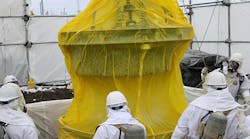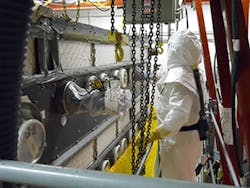When workers enter the hazardous and historic McCluskey Room at the Department of Energy's (DOE) Hanford Nuclear Reservation Site this summer, they will be much safer than the former worker for whom the room is named.
The McCluskey Room, named after worker Harold McCluskey, is part of the site’s Plutonium Finishing Plant and was used to recover americium during the Cold War. McCluskey was injured in 1976 when a vessel inside a glove box exploded and exposed him to 500 times the permissible exposure limit for americium. McCluskey, who was 64 at the time of the incident and was dubbed "Atomic Man," was dragged from the room and taken to an isolation center. Considered “too hot to handle,” the Seattle Times reports he “was removed by remote control and transported to a steel-and-concrete isolation tank.”
For five months, doctors removed shards of glass and metal from his skin and he was scrubbed down and shaved every day. All the bath towels and water were considered nuclear waste. According to the Seattle Times, McCluskey received 600 shots of zinc DTPA, which helped his body excrete the radioactive americium. He lived for 11 more years, unable to work, suffering four heart attacks in four months as well as a number of other physical ailments, until dying of coronary artery disease at age 75.
The workers who will be entering the McCluskey room this summer have been involved in planning and training for more than a year for the job. Since 2008, the DOE and contractor CH2M HILL Plateau Remediation Co. (CH2M HILL) have been preparing the Plutonium Finishing Plant for demolition by removing much of the equipment and infrastructure inside the building that was once used for plutonium processing.
“About two-thirds of the Plutonium Finishing Plant is deactivated – cleaned out and ready for demolition,” said Jon Peschong, deputy assistant manager for River and Central Plateau cleanup at the DOE’s Richland Operations Office. “Cleaning out the McCluskey Room will be a major step forward.”
When employees enter the room, they will encounter airborne radioactivity, surface contamination, confined spaces and poor ventilation. Recognizing the significant hazards, workers traveled last year to a similarly contaminated DOE site in Idaho and observed the use of advanced supplied air systems and protective suits, which they recommended for use at the Plutonium Finishing Plant. The system and equipment observed at the Idaho site has been in use for approximately nine years.
Workers also developed procedures and training tailored for using the equipment at the Plutonium Finishing Plant. The equipment includes an abrasion-resistant suit that protects workers from surface contamination and chemicals. Workers also will wear devices that will allow them to communicate with each other and for monitoring air inside the suit. A dual-purpose air system will provide cool air for breathing and cool air throughout the suit for worker comfort, allowing them to work for longer periods of time. The suit is pressurized, which helps prevent workers from coming into contact with airborne contaminants.
“The employees involved in selecting the equipment and training on the equipment are some of the most experienced employees at CH2M HILL and at Hanford,” said Mike Swartz, CH2M HILL’s vice president for the Plutonium Finishing Plant Closure Project. “Their involvement in safety has been key as they prepare to enter the McCluskey Room.”
CH2M HILL employees will improve ventilation, remove combustibles, control airborne contamination and isolate and remove electrical and mechanical items. They will remove processing equipment, such as glove boxes and tanks, to prepare that portion of the Plutonium Finishing Plant for demolition.
Hanford Workers Sickened by Fumes
Hanford officials admitted July 9 that despite taking some 12,000 air samples this year, they still can’t find a cause for the chemical vapors that reportedly sickened 38 employees working near the 177 massive underground tanks storing nuclear and chemical waste left over from the four decades Hanford produced nuclear-weapons-grade plutonium. The employees reported smelling chemical fumes, experienced a metallic taste in their mouths and suffered eye, nose and throat irritation. All have been cleared to return to work.
DOE’s Richland Operations Office is responsible for several major cleanup projects on the Hanford site, including cleanout and demolition of the high-hazard Plutonium Finishing Plant, demolition of excess facilities, excavation of contaminated soil and solid waste, and treatment of contaminated groundwater, as well as Hanford Site infrastructure. The office oversees a federal and contractor workforce of approximately 4,300 employees.
DOE’s Tom Fletcher said that even though testing has not determined a cause of the illness and none of the samples were above the PELs, DOE is not taking the issue lightly and believes that the workers are telling the truth.
"Our workers are not exposed to vapors, but they are having symptoms," said Fletcher. "The question is: 'Why?'"to that end, researchers from the Savannah River National Laboratory have been tasked with conducting an investigation and a preliminary report is expected in October.
A 1997 report from researchers at the Pacific Northwest National Laboratory that was never shared with the Hanford Advisory Board or workers concluded that emissions from underground nuclear waste tanks had the potential to cause cancer and other serious diseases if workers near the vapors weren’t wearing full respiratory protective gear. Because exposure limits were below OSHA PELs, most workers didn’t wear respiratory protection.
According to the study, the culprit was tank C-103, and long-time workers in that area had a 1 in 50 chance of developing cancer, compared with a 1 in 10,000 chance deemed acceptable by OSHA. Workers also had a greater chance of developing reproductive issues and nervous system diseases. The chance of developing serious conditions such as reproductive and nervous system diseases was deemed to be exponentially higher.



